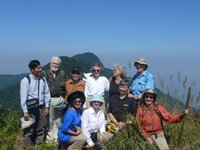Location: Viet Nam ~ Northern Forest
Where is Viet Nam?
Vietnam is in Asia, west of Japan, south of China, and east of India and Thailand (see the map in an earlier post). The word Viet is the name of the ethnic group originating from what is now northern Vietnam and southern China. The word Nam means "south of China."
Where in Vietnam is this research taking place?
The project site is north of Hanoi in the Tam Dao mountains, specifically Tam Dao National Park. The words 'Tam Dao' mean 'three mountains' and have that name because of their three mountain peaks.
Why do research in Vietnam?
Forests all over the world are being destroyed. Vietnam is only one place this is happening. Destruction is due mainly to illegal logging and population increase. The forest in Vietnam is just as important as any other forest - a healthy forest helps local people as well as people around the world. Forests help humans by providing protection from erosion as well as improved air quality around the world.
Why are butterflies important to the forest?
Butterflies are an inexpensive and natural way to monitor the health of a forest. Butterflies need a forest to survive.
What type of forests are there in Vietnam?
The geographic location makes its forest system unique. It spans both the tropical and sub-tropical regions, biomes - plus - it also falls within the Indo-Burma Biodiversity hodgepodge - which has a wide diversity of ecosystems within, including mixed wet evergreen, dry evergreen, deciduous, and montane forests.
What is the condition of the forest?
Vietnam has lost most of its natural forest. According to the World Wildlife Organization, less than 10 percent of the native vegetation in the region remains. This has been due to a combination of things; population increase, illegal logging, illegal burnoff (for farming), and of course, war. Loss of forest means loss of wildlife, because of the loss of their habitats. Remaining areas of forest in the northern region exist in small patches, scattered throughout.
Vietnam is in Asia, west of Japan, south of China, and east of India and Thailand (see the map in an earlier post). The word Viet is the name of the ethnic group originating from what is now northern Vietnam and southern China. The word Nam means "south of China."
Where in Vietnam is this research taking place?
The project site is north of Hanoi in the Tam Dao mountains, specifically Tam Dao National Park. The words 'Tam Dao' mean 'three mountains' and have that name because of their three mountain peaks.
Why do research in Vietnam?
Forests all over the world are being destroyed. Vietnam is only one place this is happening. Destruction is due mainly to illegal logging and population increase. The forest in Vietnam is just as important as any other forest - a healthy forest helps local people as well as people around the world. Forests help humans by providing protection from erosion as well as improved air quality around the world.
Why are butterflies important to the forest?
Butterflies are an inexpensive and natural way to monitor the health of a forest. Butterflies need a forest to survive.
What type of forests are there in Vietnam?
The geographic location makes its forest system unique. It spans both the tropical and sub-tropical regions, biomes - plus - it also falls within the Indo-Burma Biodiversity hodgepodge - which has a wide diversity of ecosystems within, including mixed wet evergreen, dry evergreen, deciduous, and montane forests.
What is the condition of the forest?
Vietnam has lost most of its natural forest. According to the World Wildlife Organization, less than 10 percent of the native vegetation in the region remains. This has been due to a combination of things; population increase, illegal logging, illegal burnoff (for farming), and of course, war. Loss of forest means loss of wildlife, because of the loss of their habitats. Remaining areas of forest in the northern region exist in small patches, scattered throughout.




